BEARDMORE SCULPTURE
|
The Beardmore Sculpture is sited at the junction of Beardmore Street and Dumbarton Road. A historically important location, being the disembarkation point for the 13.000 workers who were employed by the yard and adjacent to the road that led to the yards main gate.
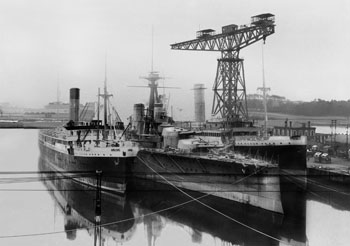 The very existence of Dalmuir as a community is intimately woven into the story of the Beardmore Naval Construction Works, established in 1906. The Beardmore story is a dynamic story of enterprise, industrial might and vision. Sadly, short lived, lasting only 25 years, the yard finally closed its gates in 1930, yet it left an indelible mark on the collective memory and environment of Dalmuir.
The very existence of Dalmuir as a community is intimately woven into the story of the Beardmore Naval Construction Works, established in 1906. The Beardmore story is a dynamic story of enterprise, industrial might and vision. Sadly, short lived, lasting only 25 years, the yard finally closed its gates in 1930, yet it left an indelible mark on the collective memory and environment of Dalmuir.
The conflict of WW1 was the force that brought the yard into being and the artist has chosen one of the yards most iconic creations from that era, the dreadnought ‘Ramillies’ as the focus of his attentions.
“The Dreadnought presents a powerful vision. It embodies much of our naval heritage and shipbuilding past. In its presence we have the embodiment of four hundred years of naval history, a deterrent, protector and guardian of British interest across the world. These mighty ships were tools of velvet glove diplomacy, symbols of immense national pride and great feats of shipbuilding and engineering skill.
"The Dreadnoughts engaged with pride the minds of the entire spectrum of British society, the public, its builders, and of course their crews and commanders. There are few objects that can make such a claim. "
" I am intrigued by a vision that has no parallel and many contradictions. An object to be feared, admired and perhaps even loved and a ship that became the ultimate vision of centuries of our islands close relationship with the sea. The Ramillies with ease meets all of these descriptions as any acquainted with her history will know.”
The sculpture is constructed from the components of the ship, commonplace to the shipbuilder and unseen by most. An inverted full scale ‘aft section frame’ above the tip of the rudder forms the main arc. Within this arc the shipbuilding components of ‘camber’ ‘sheer’ and ‘frame spacing’ are referenced. Heavy and robustly designed brackets that were used to support heavy armor decks are integrated into the tracery that forms the base, along with gently curved frames and a section of double bottom plating. Supported on four pillars high above is an interpretation of the Revenge Class Dreadnought, Ramillies, launched from Beardmore’s in 1916 |
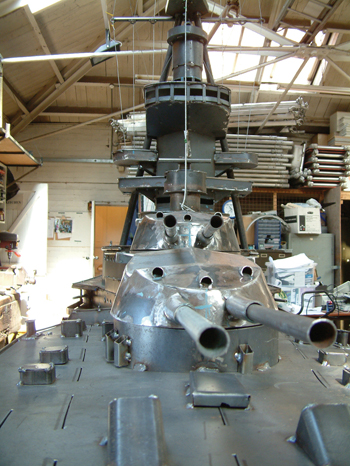 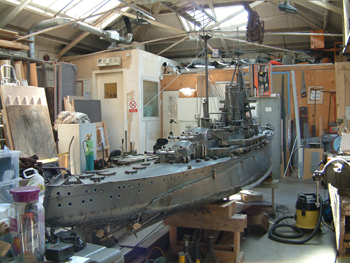 |
The interpretation of the battleship addresses the ‘distortions of the builder’ where working on an object of this scale introduces unusual perspectives. Towering above and viewed from below, the ship is elevated high on its stocks, held aloft as a monument to skill and endeavor. The great ship is a symbol of pride and purpose The sculpture is built from sheet steel and is approximately 11 meters wide by 11 meters high. The Ramillies is just over 6 meters long. |
By fortuitous luck, looking through the sculpture’s legs from Dumbarton Road in the direction of the yard exactly marks the site of the gantry where the Ramillies was built.
To the absolute delight of the artist the sculpture was visited by Freddie Smith. Freddie made the 1000 mile journey from Ontario in Canada to pay homage to the ship on which he served.
Standing in the presence of the sculpture Freddie related as a boy signalman of 18 years on the Ramilles, taking the message at the start of the invasion of Normandy. The Ramillies was ordered at 5.20 am, on 6th of June 1944 to opened fire with an eight gun broadside, her task, to destroy the guns of the Benerville battery so that the invasion could begin.

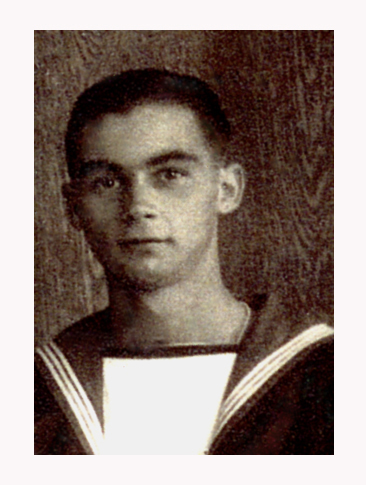 Boy Signalman Freddie A. Smith recalls “I was a young signalman at the time, positioned high on the battleship in my signal box beside the funnel. We were told that it would all begin at dawn. Our targets were the Benerville Battery Guns. These had to be put out of action so that troops could be landed and ships brought in".
Boy Signalman Freddie A. Smith recalls “I was a young signalman at the time, positioned high on the battleship in my signal box beside the funnel. We were told that it would all begin at dawn. Our targets were the Benerville Battery Guns. These had to be put out of action so that troops could be landed and ships brought in".
"At 5.20 am the ship roared into action, the noise was unbelievable, she shuddered, veered and rolled with the power of the recoil. It took four tons of explosive to fire eight fifteen-inch shells, weighing almost one ton each. We couldn't see anything for a great black cloud of smoke. The next thing I remember was being showered with debris. The power of the blast and vibration scaled the paint from the funnel. Two minutes it took for the cloud to clear and the guns to be reloaded before it all started again.”
Within eighty minutes four of the six guns had been silenced, the remaining two silenced later in the day. During her engagement she inflicted great damage on a concentration of two hundred enemy tanks, hit enemy railway marshalling yards sixteen miles inland, and succeeded in breaking up enemy units before a counter attack could be organised.
It was not a one sided battle however. Ramillies was hit twice by return fire, had five torpedoes fired at her, two coming within 25 yards and she had been dive bombed and attacked by E boats and destroyers. In the course of her Normandy engagement she fired 1,002 15-inch shells, the greatest bombardment by any single ship to that time.
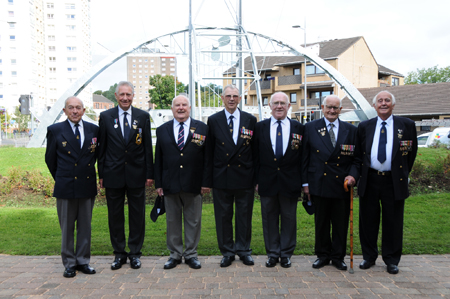 In 2010 the sculpture was visited by the Ramillies Association. In their ranks were the last remaining crew who served on the Ramilies. In their honour a reception was held by West Dunbartonshire Council in the civic chambers of Clydebank Town Hall.
In 2010 the sculpture was visited by the Ramillies Association. In their ranks were the last remaining crew who served on the Ramilies. In their honour a reception was held by West Dunbartonshire Council in the civic chambers of Clydebank Town Hall.
The serving provost spoke at the reception. "It is a great honour to have these ex servicemen visit this town. We are all aware of Clydebank's contribution to shipbuilding history and the many great ships built here for the service of the British navy. It is fitting that we as a community honour these servicemen. It is also deeply moving that the remaining members of the Ramillies crew who have a deep affection for their ship are amongst us to visit the town of her birth."

Tom McKendrick 2010
